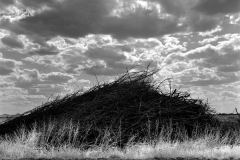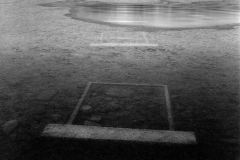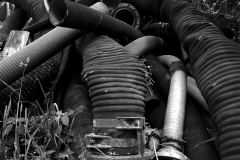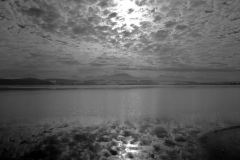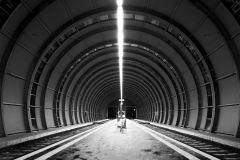The art of a second look: New photographs by Reinhart Mlineritsch
It is in the nature of photography that it isolates the displayed image detail of the world, tears it out of the context of a landscape, an architectural ensemble, an event. But it also inserts the pictures into new contexts. The viewer always perceives a photo in a frame – that of an exhibition, an advertising text or, like the photo above, a newspaper page – and thus turns it into a larger piece of the mosaic that the photographer did not know.
The title of our photo is only time and place of origin: “Trimmelkam, Upper Austria, Austria, 2000”. What does it show? An obviously natural structure, enclosed air bubbles on an ice surface. But how can you explain the light-and-shadow games behind it? So an – artificial – glass construction or maybe both: ice on a glass surface? There are many such ambiguities in the work of Salzburg-based photo artist Reinhart Mlineritsch. His motifs are diverse: there are landscapes as well as industrial and architectural photographs, nature studies in extreme close-up and alienated detailed studies of everyday objects. But what appears like an etude and arbitrary when taking a fleeting glance reveals a paradoxical aesthetic at a second glance, which is necessary for almost every picture: the utmost sharpness and richness of contrast make the object fall prey to an optical uncertainty principle. The hilly landscape from a bird’s eye view is actually a plastic film (or rather a solid paint surface?); transparent garbage bags appear as rock formations.
In analogy to the always easy to commercialize “natural wonders” – also represented in some wonderfully illuminated photos of caves and grottos – one would have to speak in the case of Mlineritschs photogrphs of “culture” – or rather “civilization wonders”: shimmering plastic films in geometric patterns, caterpillar traces in a giant Excavation pit, vegetatively growing cable ends, hoses, chain links – what must appear to the normal, still romantic view as ugly, as a degradation of nature, becomes an abstract work of art under an artificial shadow control. In the direct comparison of organically grown and made things – something of icicle stalactites and a forest of supporting pillars in the shell – the border between world and work itself becomes the subject of the picture. Mlineritsch shows that the concept of a nature that always has beauty on its side is the result of a standardization of perception. Or, in an archetype of aesthetics: that a successful work of art appears as compelling as nature itself. (Frankfurter Allgemeine Zeitung, December 6, 2003).
Analogue black and white photographs, elaborated by the author as pigment prints on baryta paper at a size of 60 x 42 cm, limited editions, dated and signed on the back (other formats on request).
You can buy original photographs of the book “Velvet Curtain”: Further information at reinhart@mlineritsch.com
